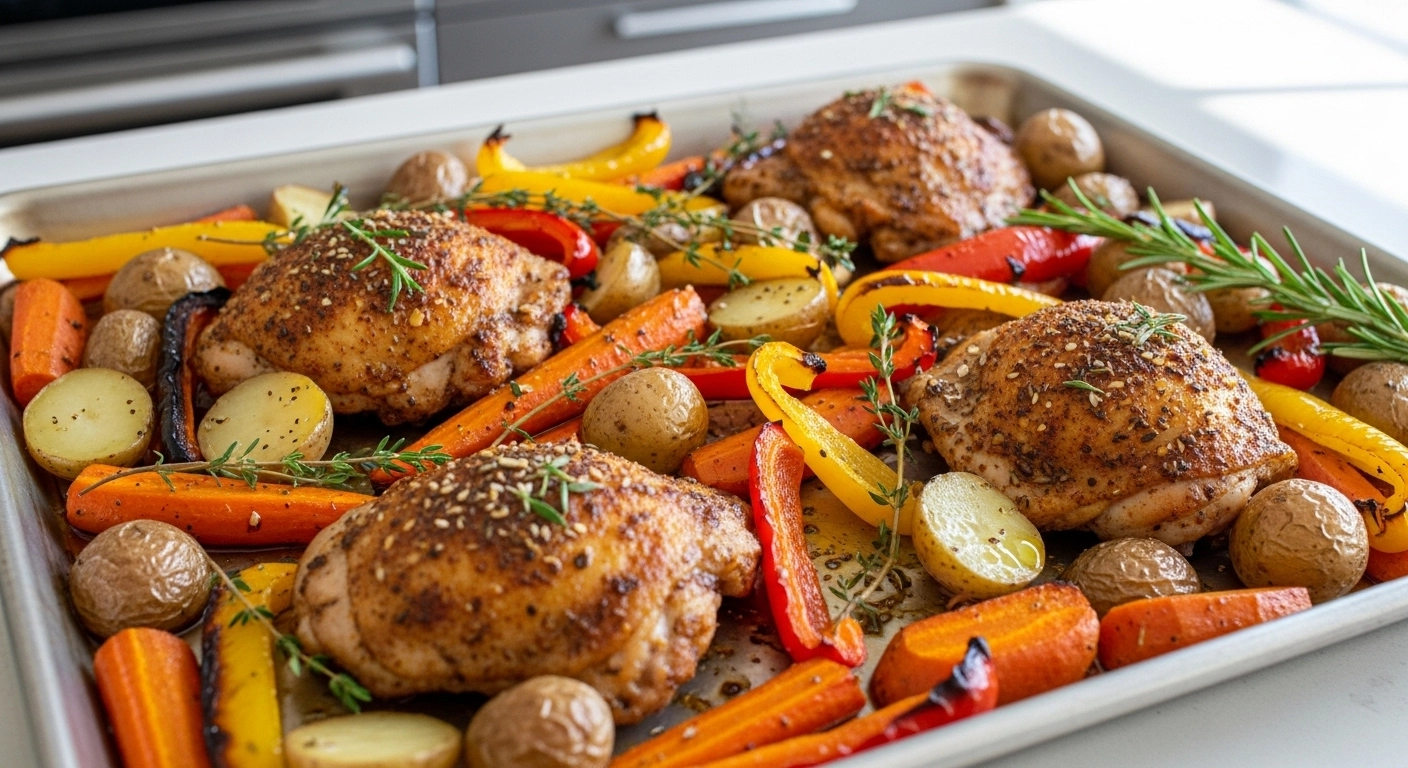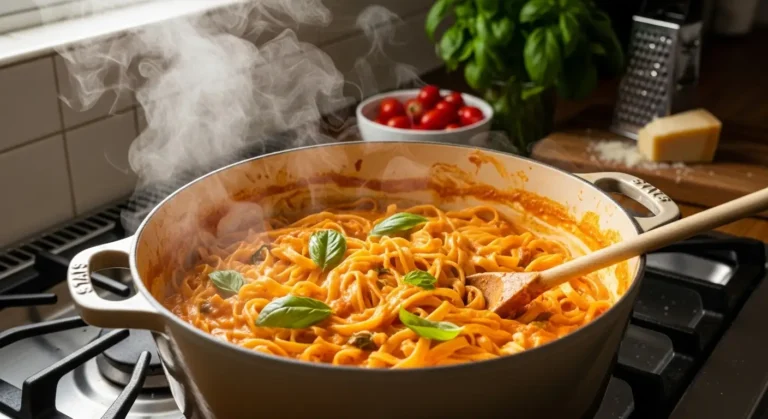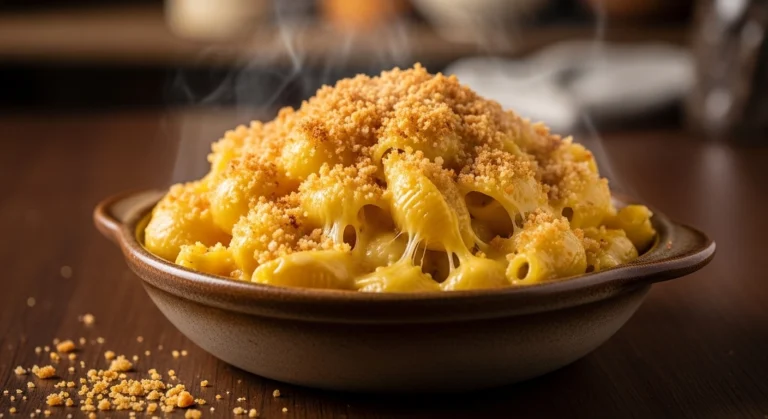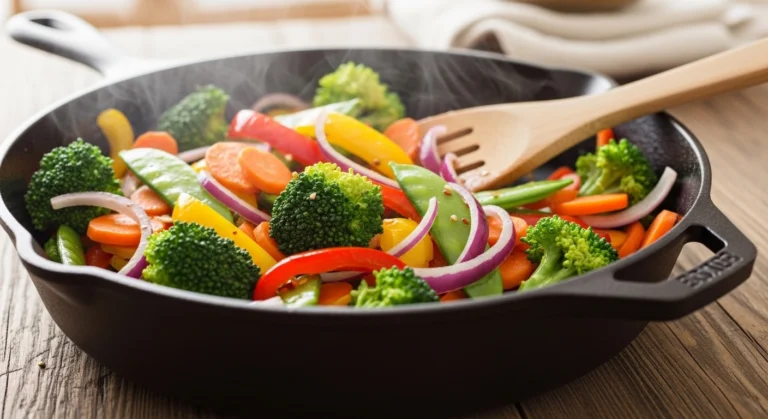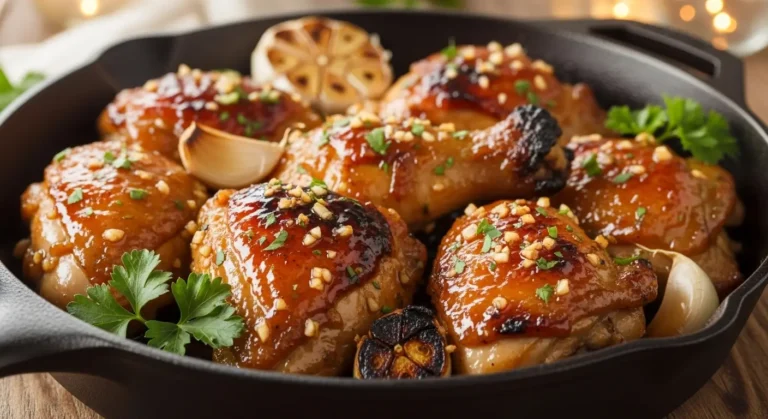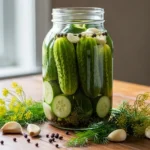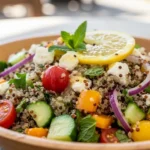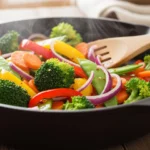Introduction
Okay, so Sheet Pan Recipes have basically become my kitchen lifesaver, and I’m not even exaggerating. You know that feeling when you get home after a crazy long day, and you’re staring at your kitchen counter like “how am I gonna make dinner without destroying my kitchen?” Yeah, that’s where sheet pan cooking swoops in like a superhero. These recipes are seriously genius – they turn regular weeknight cooking into something that’s actually doable and doesn’t leave you with a sink full of dishes.
In this guide, I’m gonna walk you through everything you need to know about Sheet Pan Recipes. We’re talking techniques, what equipment you actually need (and what’s just marketing hype), and all those little tricks that make the difference between “meh” and “wow, did you really make this?” Whether you’re totally new to this or you’ve tried it before and had some timing disasters, I’ve got you covered.
Why Sheet Pan Cooking Is Actually Life-Changing
So here’s the thing – most of us grew up watching our parents juggle like three different pots on the stove, trying to time everything perfectly. One pot for the chicken, another for veggies, maybe rice on the side… and suddenly you’re playing kitchen Tetris while everything threatens to burn at once. Sheet pan cooking just throws that whole chaotic system out the window, and honestly? It’s kind of revolutionary.
The Cool Science Stuff (Don’t Worry, I’ll Keep It Simple)
When you get what’s actually happening in your oven, everything clicks. That high heat (we’re talking 400-450°F) creates what fancy chefs call the Maillard reaction – basically, it’s that gorgeous browning that makes food taste incredible. Plus, the big flat surface of a sheet pan lets moisture escape super quick, so you don’t end up with sad, steamy vegetables.
Here’s what I love: everything’s spread out in one layer, so hot air can circulate around each piece. You get consistent results every single time, which is way harder when you’re babysitting multiple pots and pans.
Time Management That Won’t Make You Cry
Look, sheet pan cooking isn’t just about being lazy (though that’s definitely a perk). It’s about cooking in a way that actually fits into real life. You can prep everything ahead, toss it all on the pan, slide it in the oven, and go help your kids with homework or finally sit down for five minutes.
And the cleanup? I’m talking one pan, maybe a cutting board, and a couple of bowls. That’s it. Compare that to traditional cooking where you’re looking at a mountain of dishes that somehow multiplied when you weren’t looking.
Traditional Cooking Sheet Pan Cooking 3-4 pans/pots needed 1 sheet pan Constant monitoring required Mostly hands-off Complex timing coordination Simple staggered additions Extended cleanup time 5-minute cleanup Higher stress levels Relaxed cooking experience
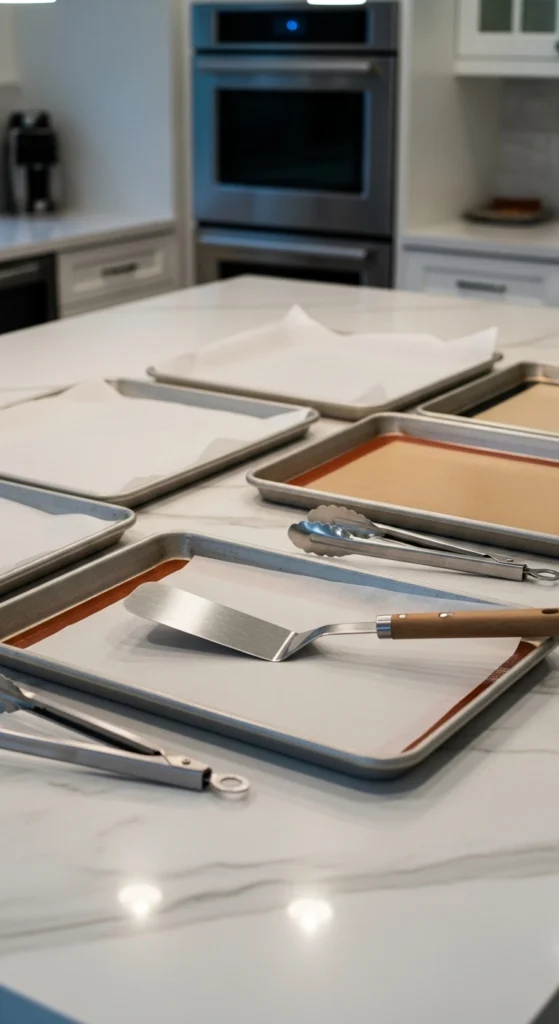
The Equipment You Actually Need
Not gonna lie – not all sheet pans are created equal, and this is one place where spending a bit more actually matters. I’ve watched cheap pans warp in the oven way too many times, so trust me on this.
Your Perfect Sheet Pan
Go for a heavy-gauge aluminum half-sheet pan, about 18×13 inches. These are the ones the pros use, and they don’t warp at high temps. Get one with rolled edges too – they’re not just for looks; they keep all those yummy juices from spilling into your oven and making a mess.
And here’s a hot take: skip the non-stick coated pans for high-heat cooking. Yeah, they seem convenient, but that coating breaks down above 400°F, which is kinda sketchy and definitely messes with your food.
Parchment Paper vs. Foil – Let’s Settle This
Parchment paper is your best friend for most Sheet Pan Recipes. It stops sticking, makes cleanup crazy easy, and can handle up to about 450°F. But if you’re cranking up the heat higher or using the broiler, switch to aluminum foil.
Some people swear by silicone baking mats (they’re reusable, which is cool), but honestly? They don’t give you that crispy texture because they trap a bit of moisture.
Other Stuff That Helps
Get yourself some good tongs for flipping stuff and stirring veggies halfway through. A thin metal spatula is clutch for flipping delicate things without destroying them. And if you’re cooking for a crowd, having multiple sheet pans is a game-changer.
Getting Temperature and Timing Right
This is where things can go south real quick, but once you get it, you’re golden. Understanding how different ingredients react to heat is what separates okay meals from amazing ones.
The Magic Temperature Range: 400-425°F
Most Sheet Pan Recipes work best in this range. It’s hot enough to get that beautiful caramelization but forgiving enough that you won’t burn everything if your timing’s slightly off.
If you’re working with delicate stuff like asparagus or cherry tomatoes, stick with 400°F. Want serious browning on Brussels sprouts or sweet potatoes? Bump it up to 425°F.
The Staggered Addition Thing (This Is Key!)
Here’s the secret: not everything takes the same time to cook. So you’re gonna add stuff in waves instead of dumping it all on at once.
Start with whatever takes longest – usually root veggies or bone-in chicken. After they’ve had a 15-20 minute head start, add your medium-cooking stuff like bell peppers or boneless chicken. Finally, toss in the quick-cooking things like leafy greens or fish in the last 10-15 minutes.
Cooking Time Category Examples Typical Addition Time Long (30-45 minutes) Potatoes, carrots, bone-in chicken Start of cooking Medium (15-20 minutes) Bell peppers, broccoli, chicken breast After 15-20 minutes Quick (5-10 minutes) Asparagus, fish, cherry tomatoes Last 10-15 minutes
Don’t Forget the Thermometer
Visual cues are great and all, but always check that your proteins hit safe temps. Chicken needs to be 165°F, fish should be 145°F. And veggies should be tender but not mushy – nobody likes sad, overcooked vegetables.
Picking the Right Ingredients
The success of your Sheet Pan Recipes really depends on what you choose and how you prep it. It’s not just about what tastes good together – it’s about how different foods handle that high heat.
Proteins That Rock on Sheet Pans
Chicken thighs are absolutely perfect because they’ve got enough fat to stay juicy even if you slightly overcook them (we’ve all been there). Plus, that rendered fat makes whatever veggies you’re cooking taste incredible. Salmon’s another winner, though it cooks way faster than chicken.
Shrimp are amazing for Sheet Pan Recipes because they cook super fast and go with pretty much anything. Just watch them carefully – they can go from perfect to rubbery in like two minutes.
Vegetables That Love the Heat
Hardy veggies like Brussels sprouts, cauliflower, and root vegetables actually get better with longer roasting. They develop these deep, complex flavors that you just can’t get any other way.
Delicate vegetables like zucchini, asparagus, and leafy greens need less time, but that intense heat still gives them those gorgeous caramelized edges.
Size Really Does Matter
This is huge: cut everything roughly the same size. Generally speaking, go a bit smaller with dense veggies like sweet potatoes compared to quicker-cooking stuff like bell peppers.
And don’t overcrowd your pan! Everything needs space to breathe. If it’s all touching, you’ll end up steaming instead of roasting, which totally defeats the point.
Making Your Food Taste Amazing
This is where Sheet Pan Recipes go from “yeah, that’s good” to “holy cow, this is incredible.” Building flavor layers throughout cooking creates depth that rivals way more complicated methods.
Start With a Good Foundation
Every single thing going on your pan needs a light coating of oil. This isn’t about drowning stuff in fat – it’s about getting proper browning and preventing sticking. Plus, the oil carries your seasonings and spreads flavors around evenly.
Salt’s obviously crucial, but don’t stop there. Garlic powder, onion powder, smoked paprika, dried herbs – they all develop deeper flavors when roasted. Just save fresh herbs for the end, or they’ll burn and taste bitter.
Mid-Cooking Magic
Here’s a pro move: add glazes or sauces partway through cooking. Like, brush barbecue sauce on chicken during the last 10 minutes so it caramelizes without burning.
Adding acid near the end – a splash of balsamic or lemon juice – brightens everything up without completely cooking away. And finishing with fresh herbs, cheese, or toasted nuts adds awesome texture.
About Marinades…
Marinades can add tons of flavor, but be careful with sugary ones that’ll burn at high temps. Consider using the marinade as a basting liquid while cooking, or save some to brush on at the end.
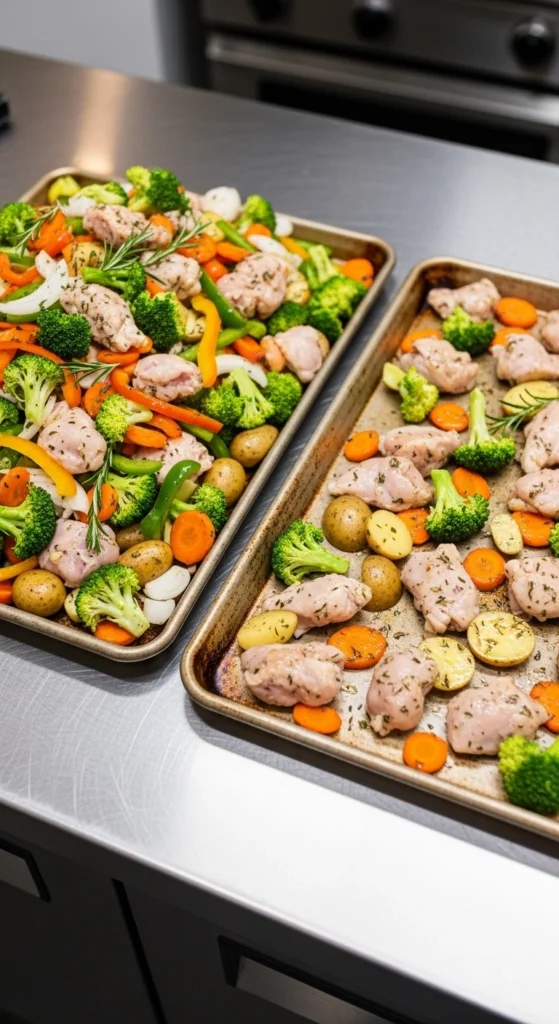
Common Mistakes (And How to Avoid Them)
Even people who cook all the time make these errors with Sheet Pan Recipes. Knowing what to avoid will seriously improve your results right from the start.
The Overcrowding Problem
This is probably the biggest mistake. When stuff’s too close together, it steams instead of roasts, and you end up with soggy, pale vegetables and sad proteins. Use two pans if you need to – don’t try to cram everything onto one.
Remember, ingredients release moisture as they cook, so even if they start with space, that liquid needs somewhere to go. Give things more room rather than less.
Temperature Fails
Cooking at too low a temp is another common issue. 350°F might feel safe, but you won’t get the browning that makes Sheet Pan Recipes special. On the flip side, going above 450°F can burn the outside while leaving the inside raw.
And please, actually preheat your oven! Give it at least 15-20 minutes to reach temperature before putting your pan in, or your timing will be completely off.
To Flip or Not to Flip
Knowing when to move stuff versus leaving it alone is crucial. Generally, plan for one flip or stir halfway through, but don’t keep opening the oven door every five minutes – you’re dropping the temperature and messing with your cooking time.
Some things benefit from flipping (chicken pieces, thick veggie cuts), while others (cherry tomatoes, asparagus) are better left alone so they don’t break apart.
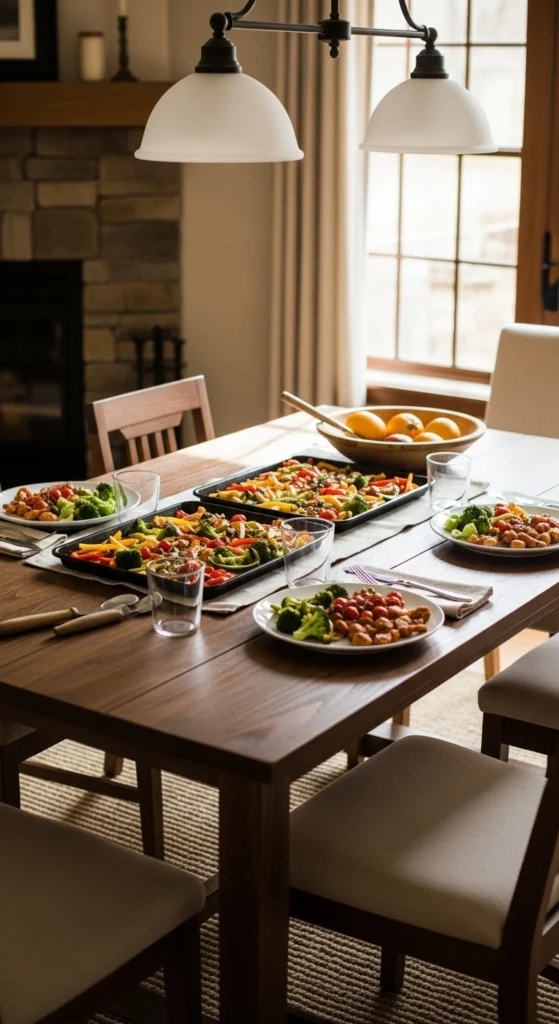
Quick Weeknight Winners
These Sheet Pan Recipes are designed for those crazy weeknights when you need something delicious but don’t have time for anything complicated.
30-Minute Shrimp and Veggies
This cooks fast enough to have dinner ready in half an hour but feels fancy enough for company. Start with asparagus, cherry tomatoes, and bell peppers on your preheated sheet pan, then add seasoned shrimp for the last 8-10 minutes.
The trick is getting the veggies started first since they take longer than shrimp. Season everything with olive oil, garlic, lemon zest, and red pepper flakes for a bright, Mediterranean vibe.
Sausage and Peppers Done Right
Using pre-cooked chicken sausage makes this one of the fastest Sheet Pan Recipes ever. Slice the sausage, toss with sliced bell peppers, onions, and maybe some zucchini, then season with Italian herbs and balsamic vinegar.
The beauty here is that everything cooks at about the same rate, so you can add it all at once. Plus, the sausage releases flavorful juices that season the veggies naturally.
Salmon and Sweet Potato Perfection
This feels restaurant-worthy but takes minimal effort. Cut sweet potatoes into small cubes and give them a 15-minute head start, then add salmon fillets and quick-cooking veggies like asparagus or green beans.
Season with olive oil, garlic, and fresh herbs like dill or parsley. The sweet potatoes give you those satisfying carbs while the salmon delivers healthy omega-3s.
Next-Level Techniques
Once you’ve got the basics down, these pro techniques will take your Sheet Pan Recipes to restaurant quality.
The Two-Pan Strategy
For bigger families or when timing is critical, using two sheet pans strategically is a total game-changer. Put your longest-cooking items on one pan and start them first, then use the second pan for quicker-cooking stuff that finishes at the same time.
This also lets you separate ingredients that might not play well together – like keeping delicate fish away from hearty root vegetables.
Sauce Integration Like a Pro
Instead of serving sauce on the side, integrate it into the cooking process. Start with basic oil and seasonings, then brush on glazes or sauces during the last 10-15 minutes to prevent burning while still developing complex flavors.
Try brushing teriyaki glaze on chicken and veggies, or add pesto to vegetables in the final minutes. This creates flavor layers you can’t get by just adding sauce after cooking.
The Broiler Finish
For restaurant-quality browning and crispy edges, switch to broil for the last 2-3 minutes. But seriously, watch it carefully – the line between perfect caramelization and burnt disaster is razor-thin under the broiler.
This works especially well with vegetables and gives them those beautiful dark edges you see in professional kitchens. It can also add final crispy texture to proteins.
Leftovers and Storage
One unexpected bonus of Sheet Pan Recipes is how well they store and transform into new meals throughout the week.
How to Store Properly
Always cool your Sheet Pan Recipes completely before storing (otherwise condensation makes everything soggy). Transfer to airtight containers instead of leaving everything on the pan, and store in the fridge for up to 3-4 days.
Glass containers work great because you can reheat directly in them, and they don’t absorb flavors like plastic sometimes does. Portion everything into meal-sized containers for easy grab-and-go lunches.
Reheating the Right Way
The microwave’s convenient, sure, but it won’t give you the best results. Instead, reheat in a 350°F oven for 10-15 minutes to restore that crispiness.
If things seem dry, add a splash of broth or water and cover with foil. Consider refreshing flavors with fresh lemon juice or herbs after reheating too.
Transform Your Leftovers
Don’t just reheat – turn your Sheet Pan Recipes into completely new meals. Roasted veggies are incredible in frittatas, grain bowls, or pasta dishes. Leftover proteins can be shredded for tacos, sandwiches, or salads.
Sometimes these secondary meals are even better than the original because the flavors have had time to meld. Consider making extra on purpose to create easy meals throughout the week.
Frequently Asked Questions
What temperature should I use for Sheet Pan Recipes?
Most Sheet Pan Recipes work best at 400-425°F. This is hot enough to create beautiful caramelization and crispy edges without burning delicate stuff. Start at 400°F if you’re new to this or working with particularly delicate items, then bump up to 425°F as you get more confident.
How do I prevent vegetables from getting soggy?
Soggy veggies usually happen from overcrowding or not using enough oil. Make sure everything has space around it for proper air circulation, and toss with enough oil to create a light, glossy coating. Don’t cover the pan during cooking either – trapped moisture will steam your food instead of roasting it.
Can I cook different proteins together on one sheet pan?
It’s tricky because different proteins have different cooking times and temperature needs. Chicken and fish, for example, cook at totally different rates. If you want to combine proteins, choose ones with similar cooking times or add them at different intervals.
How long do sheet pan meals keep in the fridge?
Properly stored Sheet Pan Recipes typically keep for 3-4 days in the refrigerator. Cool everything completely before transferring to airtight containers, and reheat in the oven rather than microwave for best texture. Glass containers work especially well.
What’s the best way to season sheet pan meals?
Start with oil, salt, and pepper, then build from there with dried herbs and spices that can handle high heat. Save delicate fresh herbs, citrus juice, and finishing seasonings for after cooking to preserve their bright flavors and prevent burning.
Should I use parchment paper or aluminum foil?
Parchment paper is generally better for most Sheet Pan Recipes because it prevents sticking and makes cleanup easier. But if you’re cooking above 450°F or using the broiler, go with aluminum foil since parchment can brown or burn at extreme temperatures.
Conclusing
Honestly, mastering Sheet Pan Recipes is one of the most valuable cooking skills you can develop. These techniques save you time, cut down on cleanup, and produce consistently delicious results that rival way more complicated methods. Once you understand the basics of timing, temperature, and ingredient selection, you can adapt these techniques to pretty much any combination of proteins and veggies.
The beauty of Sheet Pan Recipes is how flexible and forgiving they are. Whether you’re cooking for a busy family on a Tuesday night or making an impressive dinner for guests, these one-pan wonders deliver every time. The techniques you’ve learned here will serve you well beyond specific recipes – they’re foundational skills that’ll make you a more confident cook overall.
Remember, cooking doesn’t have to be complicated to be delicious. Sometimes the simplest approaches give you the most satisfying results, and Sheet Pan Recipes are perfect proof of that. So grab your sheet pan, pick your favorite ingredients, and start creating meals that bring people together without overwhelming your schedule or your sink.
Print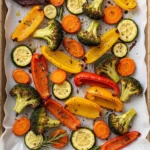
Sheet Pan Recipes: The Ultimate Guide to Easy One-Pan Dinners That Actually Work
- Total Time: 45 minutes
- Yield: 4 servings 1x
Description
Sheet Pan Recipes are a total game-changer for busy nights—simple, delicious, and way less cleanup. From shrimp and veggies to salmon and sweet potatoes, these recipes are lifesavers for the whole family.
Ingredients
- 1 sheet pan (heavy-gauge aluminum recommended)
- Parchment paper or foil
- Olive oil
- Assorted proteins: chicken thighs, salmon, shrimp, sausage
- Assorted vegetables: Brussels sprouts, cauliflower, carrots, sweet potatoes, asparagus, bell peppers, cherry tomatoes
- Seasonings: salt, pepper, garlic powder, onion powder, smoked paprika, Italian herbs
- Lemon juice, balsamic vinegar, or glazes (optional for finishing)
Instructions
- Preheat oven to 400-425°F for most sheet pan meals.
- Line your sheet pan with parchment paper or foil.
- Cut vegetables into even sizes and lightly coat with oil and seasonings.
- Start cooking longest-time items first (root vegetables, bone-in chicken).
- Add medium-cooking items like peppers, broccoli, or boneless chicken after 15-20 minutes.
- Add quick-cooking items like shrimp, fish, or asparagus in the last 10-15 minutes.
- Flip or stir once halfway through cooking if needed.
- Check proteins with a thermometer: chicken 165°F, fish 145°F.
- Finish with fresh herbs, lemon juice, or glazes for flavor.
- Serve hot, enjoy, and store leftovers properly in airtight containers.
Notes
Don’t overcrowd your sheet pan—use two pans if needed for better roasting. Always preheat your oven for even results.
- Prep Time: 15 minutes
- Cook Time: 30 minutes
- Category: Dinner
- Method: Oven Roasted
- Cuisine: American
Nutrition
- Serving Size: 1 plate
- Calories: 380
- Sugar: 5g
- Sodium: 550mg
- Fat: 20g
- Saturated Fat: 6g
- Unsaturated Fat: 12g
- Trans Fat: 0g
- Carbohydrates: 25g
- Fiber: 4g
- Protein: 28g
- Cholesterol: 85mg
Keywords: sheet pan recipes, healthy dinner, one pan meals, family meals, easy cleanup
Sources
- Food52 – Sheet Pan Dinner Tips and Recipes
https://food52.com/story/23683-best-sheet-pan-dinner-recipes-chicken-eggs-vegetables - Skinnytaste – Easy Sheet Pan Dinners Collection
https://www.skinnytaste.com/easy-sheet-pan-dinners/ - Taste of Home – One-Pan Recipe Guidelines
https://www.tasteofhome.com/collection/sheet-pan-dinners-one-hour/ - Damn Delicious – Best Sheet Pan Dinner Techniques
https://damndelicious.net/2025/07/08/15-absolute-best-and-easy-sheet-pan-dinners/ - The Kitchn – Sheet Pan Cooking Fundamentals
https://www.thekitchn.com/sheet-pan-dinners-266020 - America’s Test Kitchen – Professional Sheet Pan Methods
https://shop.americastestkitchen.com/the-sheet-pan-cookbook.html - AllRecipes – Sheet Pan Cooking Mistakes to Avoid
https://www.allrecipes.com/article/sheet-pan-dinner-mistakes/ - Food Network – Complete Sheet Pan Recipe Collection
https://www.foodnetwork.com/recipes/photos/sheet-pan-recipes

